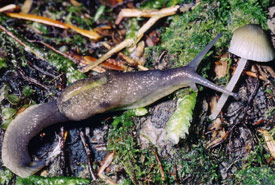Identifying and assessing species at risk

Dromedary jumping slug (Photo by Kristiina Ovaska)
The issues of habitat loss and wildlife decline are so pervasive, it would seem unlikely there are many Canadians not familiar with the terms "species at risk" or "endangered species." The term may conjure images of panda bears or tigers, but unfortunately, there is no shortage of species at risk to be found within Canada. In fact, 15 species have been lost from Canada forever (extinct) and an additional 22 are no longer found as wild populations. Currently, 471 species are classified as either endangered or threatened in Canada.
The Committee on the Status of Endangered Wildlife in Canada (COSEWIC) is a group of roughly 30 members that have the significant and serious task of reviewing scientific information and determining whether a species is at risk. They serve as official advisory body to the government of Canada and the federal Species at Risk Act.
Instituted in 1977, COSEWIC was the result of a long-recognized need for an official, science-driven classification system for species at risk in the country. While initially charged with assessing only vertebrates (anything with a spine), the mandate has expanded to include lichens, mosses, molluscs (a diverse group including snails, slugs and squid) as well as insects and spiders.
The members of the COSEWIC are supported by an extensive network of contributors that includes specialists and experts from across the country as well as an administrative secretariat. Species specialist sub-committees do much of the heavy lifting — assembling and maintaining lists of potential priority species, reviewing and categorizing and making recommendations to the central body. A total of 10 species subcommittees exist. An eleventh is focused on collection and consideration of Aboriginal traditional knowledge pertaining to species under consideration.
All species identified as high priority by the subcommittees are reviewed and form the COSEWIC Candidate List. The species on this list become the focus of a Status Report — an exhaustive compilation and thorough assessment of the knowledge about a species’ distribution, abundance, health and taxonomy.
Recently, the COSEWIC met in Halifax for annual species assessment meetings to review status reports for candidate species and determine whether they meet strictly defined criteria for one of seven potential assignments that include extinct, extirpated, endangered, threatened, special concern, data deficient, or not at risk. Discussion and debate on a species may range from 30 minutes to several hours, depending upon the availability and quality of the information presented and the level of agreement on the assessment proposed by the presenting subcommittee chair.
While the atmosphere is collegial in these discussions, the pursuit of consistency and rigour sometimes trumps patience and politeness. Some exchanges can be passionate, while most focus on facts. But facts can be interpreted very differently, given the lens through which one approaches a debate. These are people who understand these organisms better than just about anyone else but to ensure consistent application of the assessments, strict criteria guides the decision-making. Members must never lose sight of the tests and thresholds a species must meet in order to be considered endangered versus threatened or simply of special concern versus threatened.
After a week of long and arduous meetings, members having decided on the assessments for 28 species, some refining and polishing of the status reports will be undertaken before they are published publically at sararegistry.gc.ca. Notable listings from the 2014 meeting include status assignments for three populations of mountain caribou in the west, with the central and southern populations assessed as endangered and the northern as special concern. The ferocious and reclusive wolverine was also assigned as special concern. Three lesser known species were assigned the threatened status: hare-footed locoweed, dromedary jumping slug (actually a mollusc) and the sweet pepperbush, which is only found in Nova Scotia.
The complexity of the work undertaken by COSEWIC is noteworthy and the impact of their decisions can be wide-reaching. Species determined by be either endangered or threatened will generally receive statutory protection under the Species at Risk Act, though some discretion is held by the Minister of Environment. This can drive changes in policy and regulation, affect (positively or negatively) economic activity and land use and determine the distribution of government funds for recovery work.
This important application of biological science helps to drive conservation action on the ground. Species at risk recovery work is an increasingly critical element of conservation efforts. We are fortunate there is a robust and sophisticated conservation community in Canada working to address issues affecting species at risk, thought the resources fall far short of the need.
Groups like the Nature Conservancy of Canada are developing innovative approaches to land conservation and management that involved restoring habitat, eliminating threats to species and enhancing our understanding of the plants and animals around us. In most cases, the abatement of threats and stressors is essential to improving a species’ status. Species assigned a status are reviewed every 10 years.
Twenty-first century decision-making demands up-to-date, detailed information. COSEWIC members and contributors are providing decision makers the ability to make informed judgements on the legal protections afforded to wildlife in Canada. This is a significant service to the country and to efforts to conserve our full diversity of critters and creatures.


